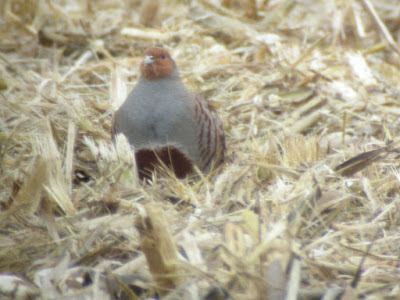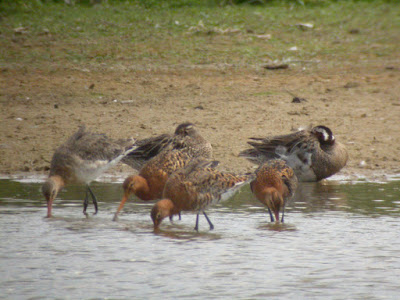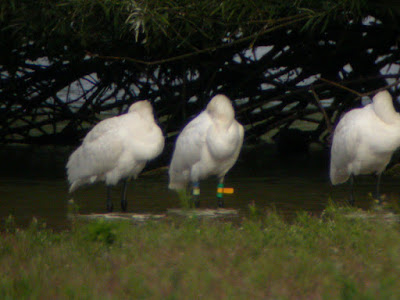The gulls were quite flighty when I got there, even the LWHG, which is quite unusual, but at least there seemed to be good numbers of larger gulls - better than on my last roost visit. It wasn't long before I picked out a nice 2nd winter Caspian Gull - it looked similar to the bird I saw before Christmas, but I thought the bill may have been a bit stronger on this bird. Shortly later, a lovely 1st winter Caspian Gull pitched up - this was a medium/large bird with quite a long looking bill. Both birds were together briefly, before they spooked again and they separated. It was a nice clear evening, so the light was pretty good which lengthened the watching time. I kept scanning and gulls kept arriving, I was hoping for a nice white winger, but one never materialised. At about 4:30pm I picked out yet another Caspian Gull, this time a 3rd winter. Initially on the water, it eventually strode out on long legs to stand on the spit. I'm not sure I have ever seen two Casps together here before, but I have definitely never seen three. It is a reflection of the numbers wintering in the region now, there have certainly been good numbers at Hedgerley landfill this winter and many of our gulls feed there during the day. The only downside was that I was unable to get any record shots of any use, as my digiscoping struggles to focus in low light, light that was fine for my eyes, but too dim for the camera. A couple of efforts are below:
 |
| The 2w in the middle |
 |
| The 1w |
As the light started to fall away, I picked out a hefty 1st winter Yellow-legged Gull wading around near the tip of the near spit. These gulls are quite scarce in the winter, more of a late summer bird here, so nice to get so early on. The only other bird I noted was a Chiffchaff around the bench prior to roost.
When the light had become too dark for meaningful identification, I walked back towards the car. I spent a little time while the light ebbed away even further, looking westwards over the car park field. Two or three years ago, there had been a regular Woodcock that used to fly out towards the meadows as darkness fell, so I always give it a look when I'm here at this time. At 17:15, a dark shape flew low over my head flying west and then veered SW over the sewage works towards the meadows - a Woodcock! Very pleased to get this species again and knowing that at least one is probably roosting on site, I'll try and give it another go or two over the next few weeks.
25th January - I decided to spend some time around the farmland at Emmetts, hoping in particular to pick up Yellowhammer, though I still needed Red-legged Partridge.
As I walked up the track, it was immediately obvious that the closest area of game cover had been cut down. A quick scan of this revealed 4 Red-legged Partridges on the far side. Apart from the usual flock of Chaffinches and Linnets and a single Meadow Pipit, I couldn't see much else. I continued a little further and looked over the bare fields to the east. I could see that there were Golden Plover here again, but they were hunkered down. I attempted a count but it was difficult and there was some estimation - I got to around 400 birds, somewhere near half way or over and they took off. My initial estimate of 600 birds soon rose to about 800 as they wheeled about overhead for ages - a marked increase on my last visit.
Whilst I had been watching these, I had heard a Grey Partridge call from somewhere close and behind me and then another from my right. I looked a couple of times before I eventually picked out a nice male in the cut game cover - very pleased with this and my first sighting since the previous winter. I am still unsure as to the origins of these birds, but in a recent conversation with a farmer who refers to partridges as French and English, so is aware of the difference, he told me that he doesn't put Grey Partridges down and always likes to see them, so they may be genuine wild birds. Based on his comments, I'll continue to give them the benefit of the doubt. The last shoot on his land is over for this period, so maybe why this bit of game cover has now gone. I watched the single male for a while and then the other bird that I had heard flew in and joined the first.
I continued my walk. At the top of the slope, a Raven flew past me and was joined by a second bird. They flew over the woodland for a bit and then disappeared. I then heard Yellowhammer calls and sure enough a small flock of 5 birds were in the tops of nearby oak trees amongst numerous Chaffinches, a handful of Reed Buntings and a single Lesser Redpoll (I only ever seem to see one of these here, but quite frequently - can it be the same bird?). They were using the trees to sit in and then flighting to another area of game cover that still stood.
 |
| poor record, poor light |
 |
| poor record, poor light |
I came across another Raven later in the afternoon flying north over the athletics track, so a three Raven day!
Edit: Dave C reported a Merlin briefly mid afternoon at Emmetts. This would be a patch tick for me and a bird I am always looking out for over these fields, so a bit gutted, but pleased that a Merlin may still be in the area.
26th January - I gave Emmetts a look today, hoping for Merlin, but it was a bit windy and gave up as the rain started. I saw 5 Grey Partridge today, a pair on one edge of the cut cover and three males on the opposite edge before moving to the longer grass by the hedge. There was also at least 38 Snipe roosting on the bare field today, but only about 200 Golden Plover, always in flight.































